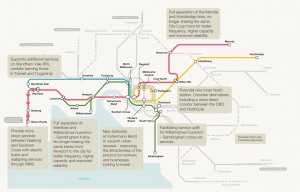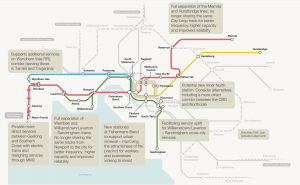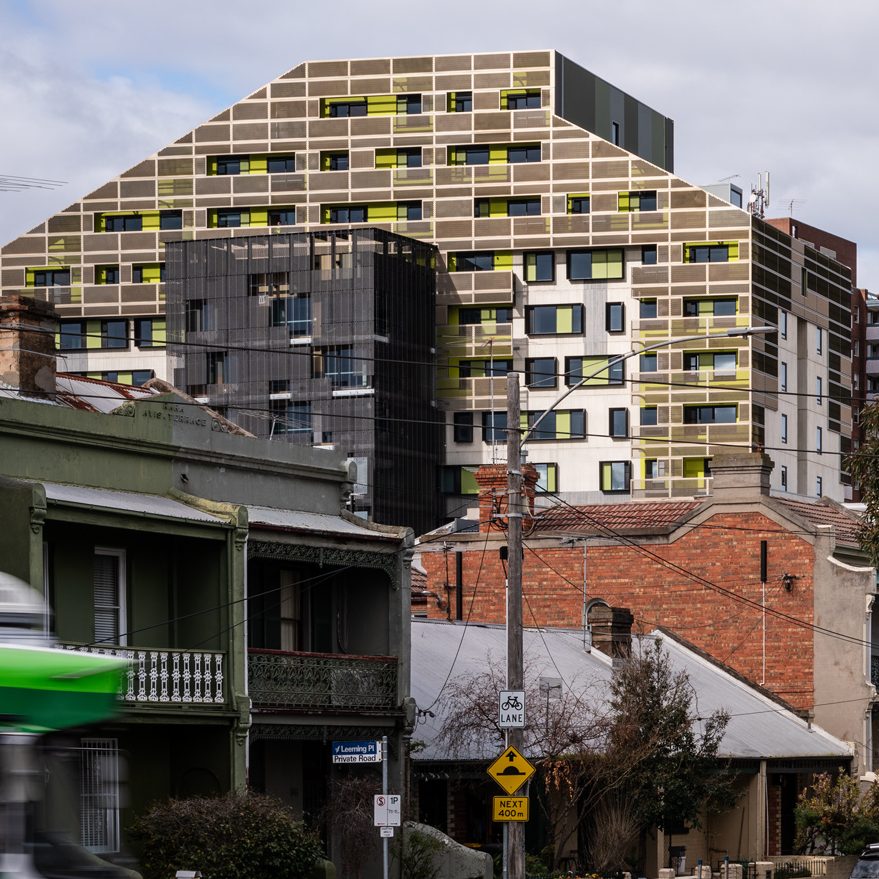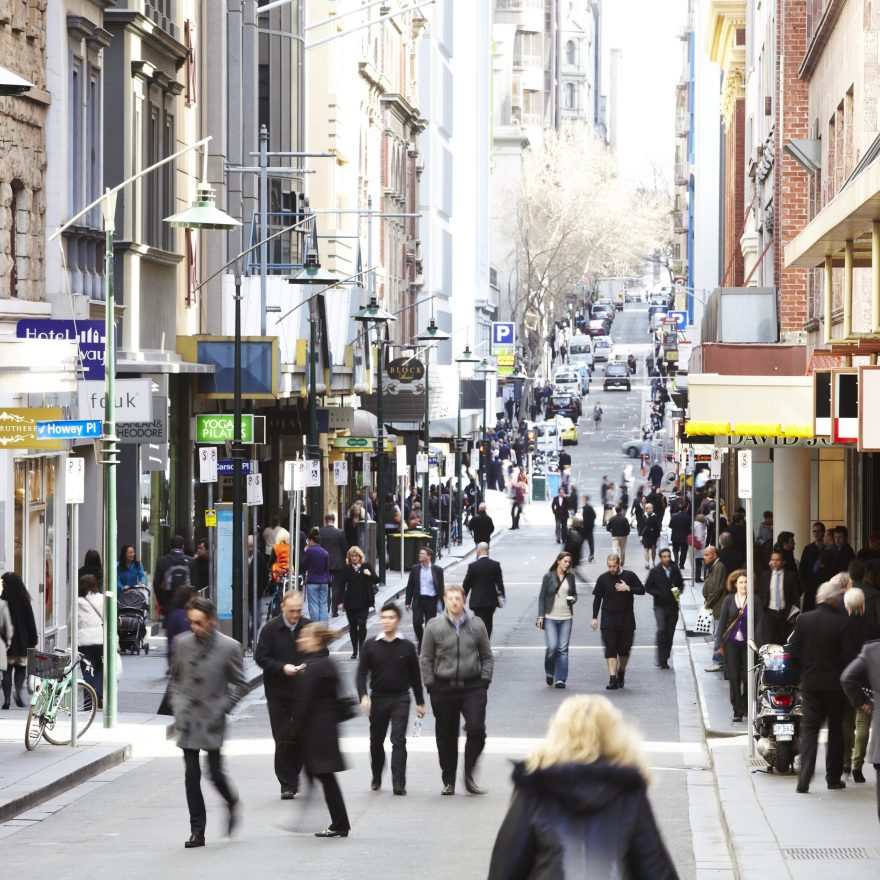Active transport
Advocacy priorities:
- Commit to early works and scoping for Melbourne Metro 2.
- Commit to commence works for the reconfiguration of the City Loop in line with the timed completion of the Metro Tunnel 1.
- Improve frequency of all-day, everyday rail and bus services on Melbourne routes to improve public transport patronage as Melbourne re-opens.
- Undertake a public transport promotion and behaviour change program to encourage a return to public transport.
- Update the Strategic Cycling Corridor Network and continue to fund and implement works on the SCCs.
- Fund a grants program to fund local walking, wheeling and riding improvements such as pedestrian crossings.
- State Government to partner with M9 councils with funding and support for the next phase of the ‘Let’s Ride Melbourne’ behaviour change program, to encourage uptake and user confidence for active transport to, from and around inner Melbourne.
Sustainable transport includes public transport, walking, wheeling and riding. M9 councils have adopted policies and strategies that have clear objectives to encourage active and public transport use above private vehicles. Identifying sustainable transport projects and initiatives that address shared challenges and deliver shared benefit is a key task for M9.
Over the long-term, M9 seek to support sustainable and manageable population growth through infrastructure prioritisation and investment.
Investment in major public transport projects is needed to support the growth and accessibility of the M9 region to support sustainable and manageable population growth. Without investment in public transport infrastructure there will be an increasing dependence on private vehicles.
Public transport contributes to a healthier environment by improving air quality and reducing car reliance, congestion and carbon emissions. M9 councils have adopted policies encouraging public transport use over private vehicles.
Infrastructure Victoria recently released Victoria’s Infrastructure Strategy 2021-2051, identifying key public transport projects that will be required in coming years and decades including Melbourne Metro 2 and reconfiguring the City Loop.
Melbourne Metro 2 is a proposed new rail line between Clifton Hill & Newport, significantly improving connections to the central city and also enable more trains on existing lines in Maribyrnong, Yarra, Melbourne & Darebin while interchanges at Southern Cross, Flagstaff and Parkville will deliver improved accessibility to the other M9 councils. Significant planning work is required to determine exact alignment.
Figure 1: Melbourne Metro 2 benefits

Reconfiguration of the City Loop will provide more cross-city suburban metro rail services for growing areas in the north and south-east of Melbourne. Constructing two relatively short tunnels will convert two of the four existing City Loop tunnels to ‘through’ operations, rather than current loop setup. In effect this will create a new double-track rail line through the central city. Trains would travel between Craigieburn and Frankston, allowing more reliable “turn-up-and-go” services to be run through the Loop and across suburban Melbourne. This would also free-up the existing Flinders St to Southern Cross tracks for more Upfield and Glen Waverly trains. Works would directly benefit M9 councils by enabling increased frequency and connectivity for. Infrastructure Victoria suggest that the optimal time to begin construction is immediately following the opening of Melbourne Metro 1.
Figure 2: Reconfiguring the City Loop benefits

Public transport investment is the responsibility of the Victorian Government. These projects would deliver significant shared benefits to service quality, crowding and frequency in inner Melbourne and encourage public transport use in line with local policies and strategies to support sustainable and manageable growth across the M9 region.
Over the short term, M9 seek to encourage and prioritise a return to public transport, walking, wheeling and bike riding as our communities re-open.
Improving frequency of all-day, everyday rail and bus services on Melbourne routes is a relatively low-cost, short-term intervention that will improve public transport patronage as Melbourne re-opens.
The metropolitan train network is expected to carry an extra 500,000 to 900,000 passengers each day by 2036.7 Increasing train service frequency will address the growing rail service demand and perceptions of overcrowding.
Introducing new, more efficient bus services also helps to improve access to larger suburban centres and new growth areas, enhancing accessibility and amenity for residents, workers and visitors. Buses do not require large, expensive, immovable infrastructure investments and can operate on most roads. The relatively low capital cost of buses means they can respond quickly to changes in population, technology, policy and behaviour.
Both interventions across rail and bus would benefit all M9 councils and could be achieved without any new infrastructure. This would also directly respond to changing travel patterns in response to the COVID-19 pandemic and associated health concerns by catering for more flexible work hours and for more non-work trips across the week, while also ameliorating the risk of continued increased private vehicle volumes.
More investment in safe, separated direct, continuous and accessible bike riding infrastructure is required to encourage a shift from recreational riding to commuter bike riding as Melbourne re-opens. M9 does not have a shared prioritisation framework for advocacy and investment in bike riding infrastructure projects.
Across the M9 region, there is significant potential for active transport uptake. In 2020, Monash University partnered with VicHealth to survey Victorians during the pandemic. Some key findings of the survey were:
- 1 in 3 Victorians said a lack of lighting was a barrier to walking more
- 1 in 2 didn’t feel safe riding on roads or near cars
- 2 in 3 may ride for transport more if bike lanes were physically separated from the road.
Encouraging a shift from recreational riding to commuter bike riding will require investment in safe, direct, separated, continuous and accessible bike riding infrastructure across the priority commuter cycling corridor network (known as Strategic Cycling Corridors) in partnerships with local governments.
Improving pedestrian crossings and providing more priority for riding, wheeling and walking makes those modes more attractive, helping to take cars off the road and improving safety.
As the COVID-19 restrictions ease and our communities return to work and life, we want to make sure as many of the people who have rediscovered walking and bike riding continue to travel by these modes.
The Victorian State government has no ongoing funding program for crossing improvements. Councils require significantly larger funding opportunities to meet the intended roles and take on greater shift to walking, wheeling and bike riding mode share.
Public transport behaviour change programs will be critical to supporting short-term change to positively shift how, when and where Victorians travel.
The COVID-19 pandemic has led to a reduction in public transport patronage in Melbourne. Some people are concerned about perceptions of inadequate space and an inability to practice social distancing in a closed environment on public transport. Notably bus patronage hasn’t reduced as much as tram and train.
There are barriers to encouraging users to return to public transport. Without intervention to support uptake in public transport alternatives, Infrastructure Victoria predict that inner metropolitan Melbourne will be significantly impacted by vehicle congestion.
Active transport behaviour change programs can significantly increase community participation in walking and bike riding, particularly users that are less confident. M9 can leverage established programs such as Let’s Ride Melbourne to encourage a shift from recreational riding to post-COVID-19 travel behaviour.
The ‘Lets Ride Melbourne’ behaviour change pilot demonstrated the potential of an integrated behaviour change program. Melbourne, Port Phillip and Yarra Council’s participated in the program with significant success, including:
- 16,000 people engaged with the program with results showing that overall people felt more confident and capable to ride safely after participating in the program.
- 59 per cent of people who identified as non-confident riders agreed the program initiative boosted their confidence to ride for transport.
- 51 per cent of participants had increased awareness of new infrastructure and 46 per cent of participants are now riding more frequently for transport.
Behaviour change programs help to educate residents on health and other benefits associated with active transport, promote available routes and new connections to destinations and communicate the broader network benefits and reduction in congestion through active transport uptake. Delivery of behaviour change programs in support of new and existing infrastructure will deliver the strongest return for investment.
The next phase of the ‘Lets Ride Melbourne’ behaviour change program is ready for implementation during the current financial year. Expansion of the behaviour change program will lead to a wider audience across the M9 area and further uptake in trips generating outside of the current behaviour change area.
References:
Infrastructure Victoria (2021a) Transporting Melbourne’s Recovery: Immediate policy actions to get Melbourne moving. Source: https://www.infrastructurevictoria.com.au/document/transporting-melbournes-recovery-january-2021/
Infrastructure Victoria (2021b) Fact Sheet: Preparing for Melbourne Metro Two. Source: https://www.infrastructurevictoria.com.au/wp-content/uploads/2021/08/Fact-sheet-Melbourne-Metro-2-preparation.pdf
Infrastructure Victoria (2021c) Fact Sheet: Reconfiguring the City Loop. Source: https://www.infrastructurevictoria.com.au/wp-content/uploads/2021/08/Fact-sheet-Melbourne-Metro-2-preparation.pdf
Infrastructure Victoria (2021d) Victoria’s infrastructure strategy 2021 – 2051. Source: https://www.infrastructurevictoria.com.au/project/30-year-strategy/
VicHealth (2020) Footpaths and bike lanes key to active travel post coronavirus. Source: https://www.vichealth.vic.gov.au/media-and-resources/media-releases/footpaths-and-bike-lanes-to-help-active-travel



